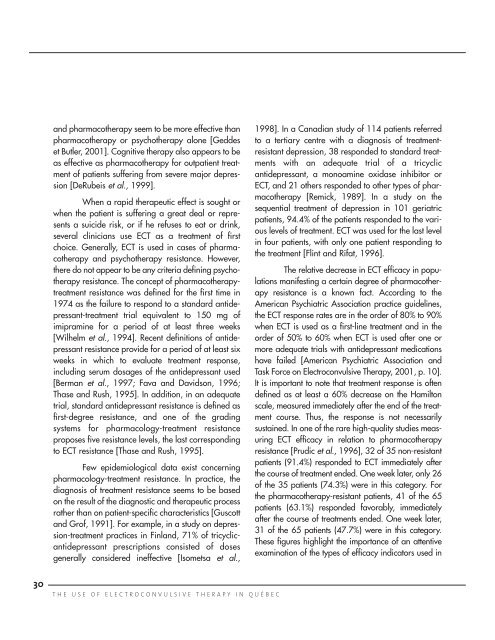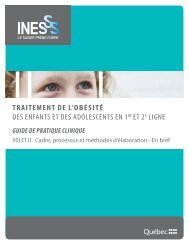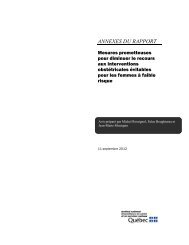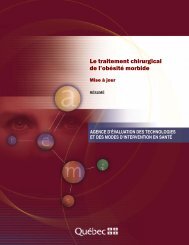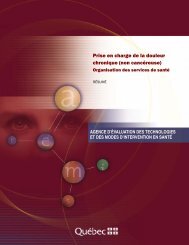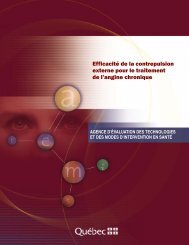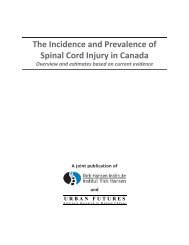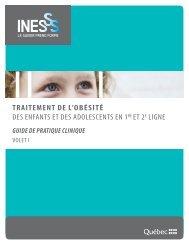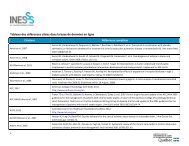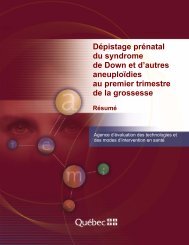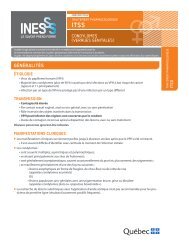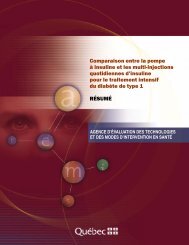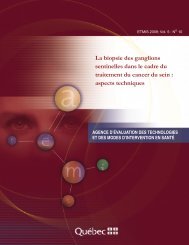The use of electroconvulsive therapy in Quebec - INESSS
The use of electroconvulsive therapy in Quebec - INESSS
The use of electroconvulsive therapy in Quebec - INESSS
Create successful ePaper yourself
Turn your PDF publications into a flip-book with our unique Google optimized e-Paper software.
30<br />
and pharmaco<strong>therapy</strong> seem to be more effective than<br />
pharmaco<strong>therapy</strong> or psycho<strong>therapy</strong> alone [Geddes<br />
et Butler, 2001]. Cognitive <strong>therapy</strong> also appears to be<br />
as effective as pharmaco<strong>therapy</strong> for outpatient treatment<br />
<strong>of</strong> patients suffer<strong>in</strong>g from severe major depression<br />
[DeRubeis et al., 1999].<br />
When a rapid therapeutic effect is sought or<br />
when the patient is suffer<strong>in</strong>g a great deal or represents<br />
a suicide risk, or if he ref<strong>use</strong>s to eat or dr<strong>in</strong>k,<br />
several cl<strong>in</strong>icians <strong>use</strong> ECT as a treatment <strong>of</strong> first<br />
choice. Generally, ECT is <strong>use</strong>d <strong>in</strong> cases <strong>of</strong> pharmaco<strong>therapy</strong><br />
and psycho<strong>therapy</strong> resistance. However,<br />
there do not appear to be any criteria def<strong>in</strong><strong>in</strong>g psycho<strong>therapy</strong><br />
resistance. <strong>The</strong> concept <strong>of</strong> pharmaco<strong>therapy</strong>treatment<br />
resistance was def<strong>in</strong>ed for the first time <strong>in</strong><br />
1974 as the failure to respond to a standard antidepressant-treatment<br />
trial equivalent to 150 mg <strong>of</strong><br />
imipram<strong>in</strong>e for a period <strong>of</strong> at least three weeks<br />
[Wilhelm et al., 1994]. Recent def<strong>in</strong>itions <strong>of</strong> antidepressant<br />
resistance provide for a period <strong>of</strong> at least six<br />
weeks <strong>in</strong> which to evaluate treatment response,<br />
<strong>in</strong>clud<strong>in</strong>g serum dosages <strong>of</strong> the antidepressant <strong>use</strong>d<br />
[Berman et al., 1997; Fava and Davidson, 1996;<br />
Thase and Rush, 1995]. In addition, <strong>in</strong> an adequate<br />
trial, standard antidepressant resistance is def<strong>in</strong>ed as<br />
first-degree resistance, and one <strong>of</strong> the grad<strong>in</strong>g<br />
systems for pharmacology-treatment resistance<br />
proposes five resistance levels, the last correspond<strong>in</strong>g<br />
to ECT resistance [Thase and Rush, 1995].<br />
Few epidemiological data exist concern<strong>in</strong>g<br />
pharmacology-treatment resistance. In practice, the<br />
diagnosis <strong>of</strong> treatment resistance seems to be based<br />
on the result <strong>of</strong> the diagnostic and therapeutic process<br />
rather than on patient-specific characteristics [Guscott<br />
and Gr<strong>of</strong>, 1991]. For example, <strong>in</strong> a study on depression-treatment<br />
practices <strong>in</strong> F<strong>in</strong>land, 71% <strong>of</strong> tricyclicantidepressant<br />
prescriptions consisted <strong>of</strong> doses<br />
generally considered <strong>in</strong>effective [Isometsa et al.,<br />
THE USE OF ELECTROCONVULSIVE THERAPY IN QUÉBEC<br />
1998]. In a Canadian study <strong>of</strong> 114 patients referred<br />
to a tertiary centre with a diagnosis <strong>of</strong> treatmentresistant<br />
depression, 38 responded to standard treatments<br />
with an adequate trial <strong>of</strong> a tricyclic<br />
antidepressant, a monoam<strong>in</strong>e oxidase <strong>in</strong>hibitor or<br />
ECT, and 21 others responded to other types <strong>of</strong> pharmaco<strong>therapy</strong><br />
[Remick, 1989]. In a study on the<br />
sequential treatment <strong>of</strong> depression <strong>in</strong> 101 geriatric<br />
patients, 94.4% <strong>of</strong> the patients responded to the various<br />
levels <strong>of</strong> treatment. ECT was <strong>use</strong>d for the last level<br />
<strong>in</strong> four patients, with only one patient respond<strong>in</strong>g to<br />
the treatment [Fl<strong>in</strong>t and Rifat, 1996].<br />
<strong>The</strong> relative decrease <strong>in</strong> ECT efficacy <strong>in</strong> populations<br />
manifest<strong>in</strong>g a certa<strong>in</strong> degree <strong>of</strong> pharmaco<strong>therapy</strong><br />
resistance is a known fact. Accord<strong>in</strong>g to the<br />
American Psychiatric Association practice guidel<strong>in</strong>es,<br />
the ECT response rates are <strong>in</strong> the order <strong>of</strong> 80% to 90%<br />
when ECT is <strong>use</strong>d as a first-l<strong>in</strong>e treatment and <strong>in</strong> the<br />
order <strong>of</strong> 50% to 60% when ECT is <strong>use</strong>d after one or<br />
more adequate trials with antidepressant medications<br />
have failed [American Psychiatric Association and<br />
Task Force on Electroconvulsive <strong>The</strong>rapy, 2001, p. 10].<br />
It is important to note that treatment response is <strong>of</strong>ten<br />
def<strong>in</strong>ed as at least a 60% decrease on the Hamilton<br />
scale, measured immediately after the end <strong>of</strong> the treatment<br />
course. Thus, the response is not necessarily<br />
susta<strong>in</strong>ed. In one <strong>of</strong> the rare high-quality studies measur<strong>in</strong>g<br />
ECT efficacy <strong>in</strong> relation to pharmaco<strong>therapy</strong><br />
resistance [Prudic et al., 1996], 32 <strong>of</strong> 35 non-resistant<br />
patients (91.4%) responded to ECT immediately after<br />
the course <strong>of</strong> treatment ended. One week later, only 26<br />
<strong>of</strong> the 35 patients (74.3%) were <strong>in</strong> this category. For<br />
the pharmaco<strong>therapy</strong>-resistant patients, 41 <strong>of</strong> the 65<br />
patients (63.1%) responded favorably, immediately<br />
after the course <strong>of</strong> treatments ended. One week later,<br />
31 <strong>of</strong> the 65 patients (47.7%) were <strong>in</strong> this category.<br />
<strong>The</strong>se figures highlight the importance <strong>of</strong> an attentive<br />
exam<strong>in</strong>ation <strong>of</strong> the types <strong>of</strong> efficacy <strong>in</strong>dicators <strong>use</strong>d <strong>in</strong>


